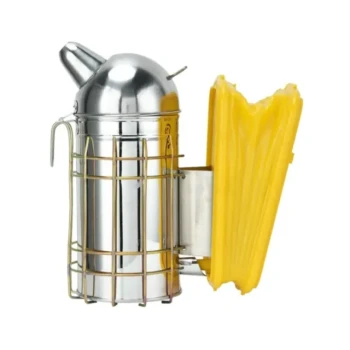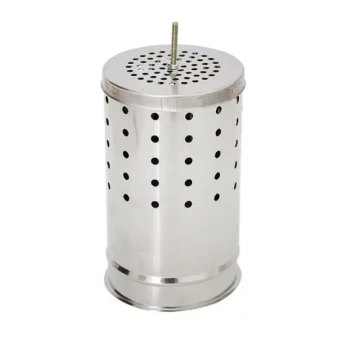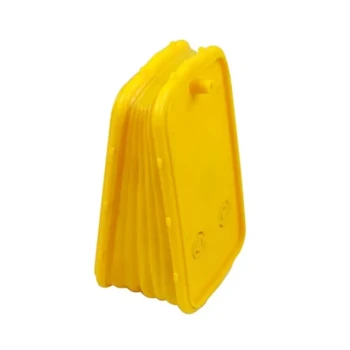In beekeeping, an open flame in your smoker is a critical mistake. The primary reason is that an open flame produces excessive heat, which can easily harm the bees and damage the delicate wax structure of the hive. The entire purpose of a smoker is to generate a large volume of cool, calming smoke, not a jet of dangerous heat.
The fundamental misunderstanding is thinking of a bee smoker as a fire starter. It is a smoke generator. Its correct function relies on a slow, smoldering burn that produces thick, cool smoke, while an open flame creates the opposite: thin, hot smoke and dangerous levels of heat.
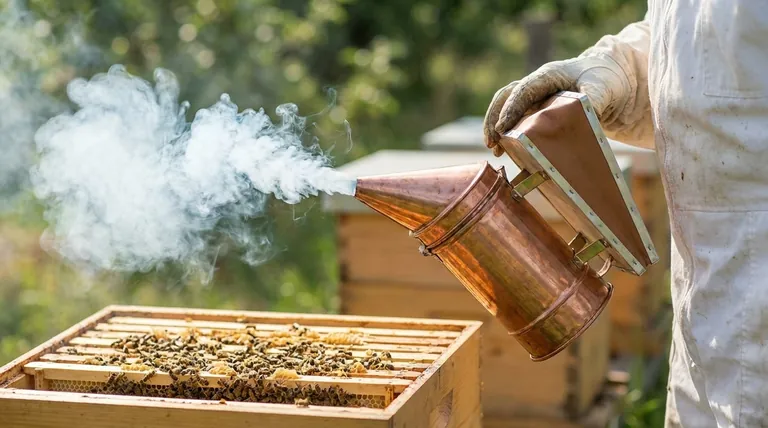
The True Goal: Calming Bees, Not Attacking Them
The smoke from a bee smoker serves two primary functions to calm a hive, neither of which requires high heat. Understanding this is key to using the tool correctly.
Masking Alarm Pheromones
When bees feel threatened, they release alarm pheromones to signal danger to the rest of the colony. Smoke effectively masks these chemical signals, preventing a panic from spreading throughout the hive.
Triggering a Feeding Response
Smoke also triggers a survival instinct in bees. They perceive it as a distant forest fire, prompting them to engorge themselves on honey in case they need to abandon the hive. A full bee is a calm bee, making it far less likely to sting.
Why an Open Flame Is a Failure State
An open flame directly undermines the calming purpose of a smoker and introduces unnecessary risks. It signifies that the smoker is not functioning as designed.
It Produces Dangerous Heat
The most immediate danger of an open flame is the intense heat it projects. This heat can singe the delicate wings of your bees, harm the vulnerable brood, and even begin to melt the beeswax comb, which can destroy honey, eggs, and larvae.
It Creates the Wrong Kind of Smoke
A hot, fast-burning fire consumes fuel inefficiently. It produces a thin, acrid smoke that is far less effective at calming bees than the thick, white smoke produced by a proper smolder.
It Is an Uncontrolled Fire Hazard
An open flame can easily shoot embers or flame out of the smoker's spout. This creates a significant fire risk, especially when working in dry conditions or around wooden hive components.
Achieving the Correct Smolder
The smoker is engineered to create smoke through a specific process. It is designed for airflow to move from the bottom up, through the fuel.
The Flame Stays Below
Your fire starter or initial flame should be at the very bottom of the smoker's fire chamber. This establishes a bed of hot coals.
Fuel Is Layered on Top
You then add your primary fuel (such as pine needles, wood shavings, or cotton) on top of this hot base. Do not mix it in.
Airflow Creates the Smolder
When you pump the bellows, air is forced in from the bottom. This air passes up through the hot coals and then through the fuel above. This process heats the fuel enough to produce dense smoke without allowing it to burst into a full-blown flame.
Making the Right Choice for Your Hive
Your goal is always a consistent stream of cool, white smoke. If you are not achieving this, adjust your technique.
- If you see a flame coming from the spout: Your smoker is too hot. Add more fuel on top to smother the flame and produce more smoke.
- If the smoke feels hot on your hand: Your fuel is burning too quickly. Gently tamp the fuel down to compact it, slowing the burn and cooling the smoke.
- If your smoker keeps going out: You likely do not have a strong enough base of coals. Ensure your starter material is well-lit and has burned long enough to create a hot, sustainable ember bed before adding the rest of your fuel.
Mastering a cool, smoldering smoke is the hallmark of a calm, confident, and effective beekeeper.
Summary Table:
| Problem with Open Flame | Consequence |
|---|---|
| Dangerous Heat | Can singe bee wings, harm brood, and melt wax comb. |
| Wrong Smoke Type | Produces thin, acrid smoke instead of thick, calming smoke. |
| Fire Hazard | Risk of shooting embers, threatening the hive and surroundings. |
Achieve Calm, Productive Hives with Professional-Grade Smokers from HONESTBEE
Mastering the perfect smolder is essential for safe and effective beekeeping. For commercial apiaries and equipment distributors, using reliable, well-designed equipment is key to protecting your investment and ensuring hive health.
At HONESTBEE, we supply high-quality, durable smokers and beekeeping supplies engineered for optimal performance. Our wholesale-focused operations provide the equipment you need to work confidently and efficiently.
Contact HONESTBEE today to explore our range of professional beekeeping supplies and elevate your beekeeping practice.
Visual Guide
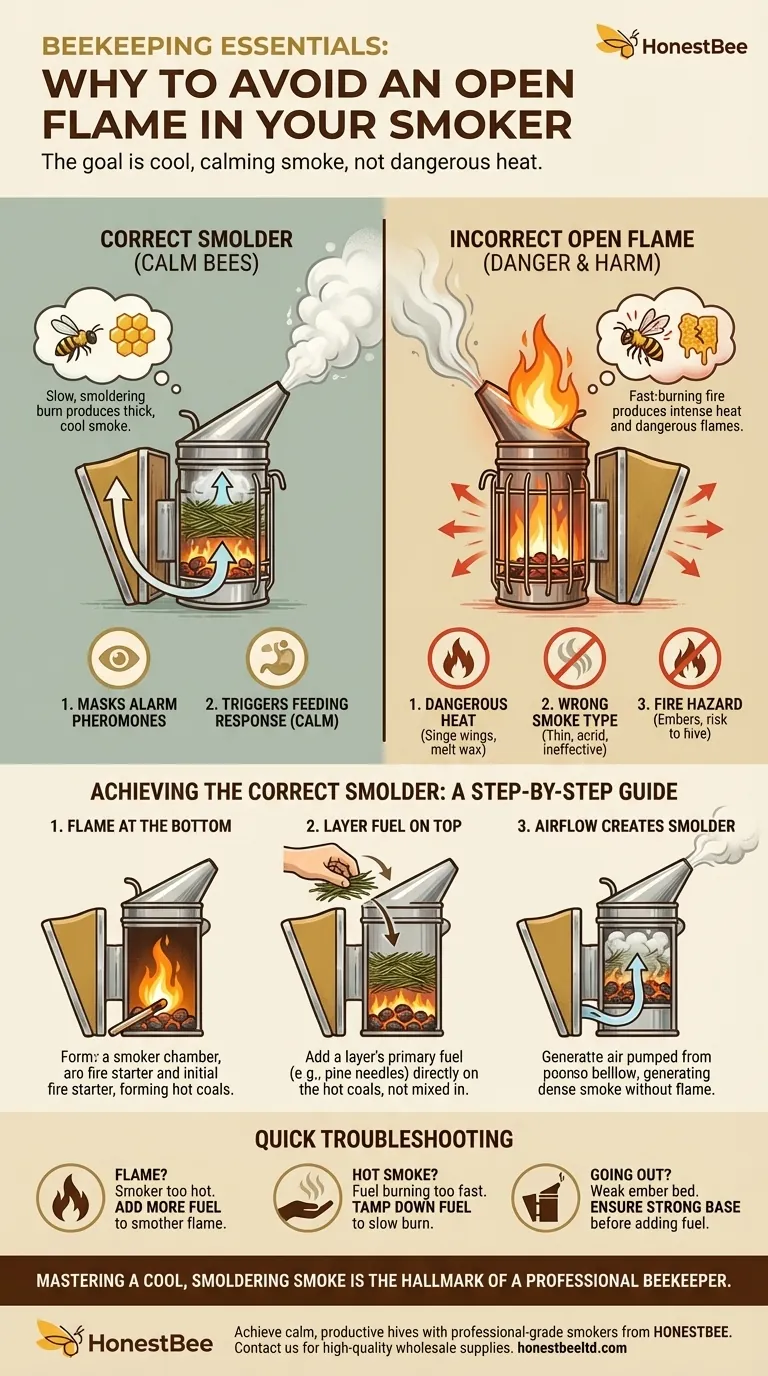
Related Products
- Premium Traditional Copper Bee Smoker with Bellows
- 54-Piece Smoker Fuel Pellets for Beekeeping Beehive Smoker Fuel
- Stainless Steel Honey Bee Smoker Hive and Honeycomb Smoker for Beekeeping
- Electric Bee Smoker European Style Bee Hive Smoker for Beekeeping
- Economy Galvanized Beekeeping Honey Bee Smoker for Wholesale
People Also Ask
- What are some alternatives to using smoke in beekeeping? A Guide to Gentle Hive Management
- How does water mist work as an alternative to smoke in beehives? A Guide to Safe & Effective Use
- What happens to bees when they sense smoke? Unlock the Secret to Calm Hive Inspections
- What are the benefits of using smoke properly in beekeeping? Achieve Calm, Safe Hive Inspections
- What are the main components of a bee smoker? A Guide to Safe and Effective Hive Management










